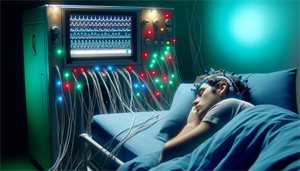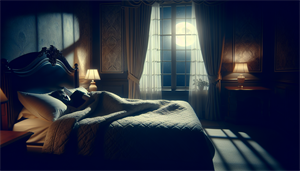A good night’s sleep is a luxury that many of us take for granted, but for approximately 22 million Americans, it’s a nightly struggle. Sleep apnea, a condition characterized by repetitive interruptions in breathing during sleep, is a serious sleep disorder that often remains misunderstood.
Understanding the difference between obstructive and central sleep apnea, the two primary classifications of this condition, obstructive sleep apnea (OSA) and central sleep apnea (CSA), present unique challenges in diagnosis and treatment, but distinguishing between them is crucial to improving patients’ health and quality of sleep.
Key Takeaways
-
Obstructive sleep apnea (OSA) is the most common form, caused by physical throat blockage, while central sleep apnea (CSA) is less common and due to brain signal failures affecting breathing muscles.
-
The diagnosis of both OSA and CSA involves identifying specific symptoms and conducting a sleep study, with distinct treatments available including CPAP therapy, lifestyle changes, and medical interventions.
-
Complex Sleep Apnea Syndrome is emerging as a new type characterized by coexisting OSA and CSA, primarily noticed when patients with OSA show CSA symptoms during CPAP treatment.
Unraveling the Two Types of Sleep Apnea
While sleep apnea is a common sleep disorder, the two primary types - central and obstructive sleep apnea - are distinct in their causes and prevalence. Obstructive sleep apnea (OSA), the most prevalent form of sleep apnea, is attributed to the obstruction of throat tissues and throat muscles. On the other hand, central sleep apnea (CSA), a rarer form, is linked to a brain malfunction impacting the signals directed to the breathing-controlling muscles.
Discerning the distinction between these two types of sleep apnea paves the way for effective treatment. Both conditions interrupt normal sleep patterns and, consequently, can negatively impact an individual’s daily life, but their treatments are different. Therefore, correctly identifying the type of sleep apnea is the first step towards improving one’s quality of sleep and overall health.
Obstructive Sleep Apnea Explained
Obstructive Sleep Apnea (OSA) is a condition that affects millions of adults worldwide. In the United States alone, an estimated 39 million adults are affected by this sleep disorder.
During sleep, the partial or complete blockage of the throat tissues causes interruptions in the supply of oxygen, leading to the condition. This can result in difficulty breathing and can be a serious health concern. The obstruction occurs when the throat muscles relax during sleep, causing the airway to narrow or close as you breathe in.
As the most common type of sleep apnea, OSA occurs in approximately 3% to 7% of the adult population. Yet, despite its widespread occurrence, it is frequently undiagnosed. This is because its most noticeable symptom, loud snoring, is often dismissed as a general nuisance rather than a sign of a serious sleep disorder. However, OSA can interfere with reaching deep, restful stages of sleep, thus degrading the overall quality of sleep.
Central Sleep Apnea Unveiled
While OSA is the most common form of sleep apnea, Central Sleep Apnea (CSA) is less common but equally serious. Unlike OSA, which is caused by a blockage in the throat, CSA is characterized by the brain’s inability to transmit appropriate signals to the respiratory muscles during sleep. This failure of the brain to communicate with the breathing muscles results in periods of interrupted breathing, which is when central sleep apnea occurs. Understanding central sleep apneas is crucial for proper diagnosis and treatment.
Diagnosing CSA can be challenging due to its symptom similarity with OSA. However, CSA symptoms may also include abrupt awakenings, shortness of breath, and difficulty sleeping. CSA is often linked to various medical conditions such as heart failure, atrial fibrillation, ischemic stroke, spinal cord injury, renal failure, Cheyne-Stokes breathing, and chronic opioid use. Hence, an inclusive medical assessment is vital for precise diagnosis and fitting treatment.
Dissecting the Symptoms of OSA and CSA

Grasping the symptoms of sleep apnea is vital for its prompt detection and treatment. Both OSA and CSA share some common symptoms, including observed episodes of not breathing during sleep, sudden awakenings with shortness of breath, and difficulty staying asleep. However, there are also distinct symptoms that can help differentiate the two conditions.
The predominant symptom of Obstructive Sleep Apnea is loud snoring, caused by the partial or complete blockage of the throat tissues during sleep. On the other hand, Central Sleep Apnea symptoms include:
-
Restless sleep
-
Low energy
-
Difficulty concentrating
-
Memory impairment
-
Waking up unrested
-
Poor quality sleep
-
Nocturnal awakening
-
Sleep fragmentation
-
Excessive daytime sleepiness (EDS)
-
Morning headaches
-
Fatigue
-
Impaired concentration span
Identifying these symptoms and pursuing medical help can notably enhance one’s quality of life and avert possible health issues.
Recognizing Obstructive Sleep Apnea Symptoms
In addition to loud snoring, individuals with Obstructive Sleep Apnea may also experience choking and gasping for air during sleep. However, not all snoring is indicative of OSA. Snoring resulting from OSA is generally distinguished by periods of interrupted breathing, a feature absent in regular snoring.
Secondary symptoms of OSA, which may not be immediately apparent, include:
-
Depression
-
Fatigue
-
Concentration difficulties
-
Impotence
-
High blood pressure
-
Nocturia (night-time urination)
-
Bruxism (teeth grinding)
-
Non-restorative sleep
-
Heartburn
These symptoms can exacerbate the disruption in one’s daily life and introduce additional health hazards, emphasizing the need for prompt detection and treatment.
Identifying Central Sleep Apnea Indicators
While the symptoms of Central Sleep Apnea mirror those of OSA, there are a few distinct indicators. These include:
-
Observed episodes of not breathing during sleep
-
Excessive daytime sleepiness
-
Conditions such as congestive heart failure, hypothyroid disease, kidney failure, neurological diseases such as Parkinson’s disease and Alzheimer’s disease, stroke, diabetes mellitus, hypothyroidism
-
Morning headaches
-
Restless sleep
Individuals with CSA may also experience abrupt awakenings accompanied by dyspnea, often attributed to conditions related to congestive heart failure or other cardiac dysfunctions. Difficulty sleeping may be attributed to underlying conditions such as heart failure and stroke. Identifying these symptoms is vital for a swift diagnosis and successful treatment.
Risk Factors That Influence Sleep Apnea Development
Similar to having shared symptoms, there also exist shared risk factors that can heighten the chance of developing sleep apnea. Lifestyle habits such as obesity and smoking are known contributing factors. Additionally, there is evidence to suggest that sleep apnea may have a genetic component, indicating that a family history of the disorder could elevate an individual’s risk.
Predisposing Factors for Obstructive Sleep Apnea
Certain risk factors are specific to Obstructive Sleep Apnea. For instance, obesity can elevate the probability of developing OSA as a result of fat accumulation in the upper airway. Moreover, aging increases the risk, with 56% of individuals aged 65 and older being at a high risk of developing OSA due to changes in sleep quantity and quality associated with old age.
Narrow airways are more prone to collapsing during sleep, leading to interrupted airflow and predisposing individuals to Obstructive Sleep Apnea. Chronic nasal congestion is also considered a risk factor as it leads to mouth breathing, which can destabilize the upper airway and increase the likelihood of its collapse during sleep.
Conditions Elevating Central Sleep Apnea Risk
Central sleep apnea, on the other hand, has its unique set of risk factors. It is frequently observed in individuals with heart disorders such as heart failure and atrial fibrillation. Brain conditions can elevate the likelihood of CSA by interfering with the usual communication between the brain and the breathing muscles, resulting in insufficient breathing regulation. These factors may contribute to an individual’s tendency to develop central sleep apnea.
Other notable risk factors include high altitude, which can exacerbate CSA symptoms due to the reduced oxygen levels in the environment, and opioid use, which has been associated with an increased risk of central sleep apnea due to its ability to depress the respiratory system and disrupt the body’s normal respiratory patterns.
Complications Arising from Sleep Apnea

Sleep apnea doesn’t only disrupt sleep; it could also result in multiple health issues if neglected. Individuals diagnosed with sleep apnea syndrome are at a heightened risk of experiencing systemic complications such as systemic hypertension, pulmonary hypertension, and arrhythmias such as atrial fibrillation.
Moreover, sleep apnea is closely linked to the emergence of mood disorders like depression and anxiety, resulting in mood and cognitive deficiencies. Excessive daytime sleepiness is another prevalent symptom of sleep apnea due to its disruption of normal sleep patterns, which in turn hinders the ability to obtain restful sleep.
It can also lead to challenges in:
-
Judgment
-
Impulse control
-
Executive function
-
Visuospatial memory
-
Vigilance
-
Psychomotor skills
-
Social cognition
-
Global cognition
Ultimately, it can impact concentration and memory.
Diagnosing Sleep Apnea: Understanding the Sleep Study

The diagnosis of sleep apnea entails a thorough assessment incorporating a sleep study. The primary method for diagnosing both obstructive and central sleep apnea is nocturnal polysomnography (PSG), a comprehensive sleep study monitoring multiple body functions during sleep.
Physicians diagnose OSA by employing a sleep test that assesses cardiorespiratory and brain activity during sleep, usually through nocturnal polysomnography. For CSA, polysomnography shows recurrent central apneas while excluding alternative diagnoses. Comprehending the significance and role of a sleep study is vital in sleep apnea diagnosis and treatment.
Innovative Treatments for Sleep Apnea Patients

Thanks to medical technology advancements, numerous effective treatments for sleep apnea management are now available. These include:
-
Lifestyle changes
-
Continuous positive airway pressure (CPAP) therapy
-
Oral appliances
-
Positive airway pressure (PAP) machines
-
Supplemental oxygen
The most recent developments in CPAP therapy involve the incorporation of mobile health technology, combining wearable sleep trackers with CPAP machines to facilitate personalized care. Meanwhile, oral appliances aid in the treatment of obstructive sleep apnea by alleviating physical obstructions in the upper airway, promoting regular breathing patterns during sleep.
Addressing Obstructive Sleep Apnea
Addressing Obstructive Sleep Apnea necessitates a blend of lifestyle changes and application of medical devices. Here are some strategies that can significantly improve the condition:
-
Weight loss
-
Increased physical activity
-
Cessation of alcohol and tobacco use
-
Avoidance of specific medications
-
Adjustments to sleep patterns
In addition to these lifestyle changes, CPAP therapy plays an integral role in managing OSA. It functions by administering air at a sufficient pressure to prevent the collapse of the airway, enabling the individual to breathe effortlessly and experience uninterrupted sleep.
Managing Central Sleep Apnea
Central Sleep Apnea treatment adopts a more inclusive approach, with emphasis on identifying root causes, managing any triggering factors, and evaluation by a sleep specialist. Treatment emergent central sleep apnea may also be addressed using medical devices like Adaptive Servo-Ventilation (ASV). ASV is a noninvasive ventilatory therapy that delivers varying levels of inspiratory pressure to address the reduction or cessation of breathing during central hypopnoeas and apnoeas.
In some cases, surgical intervention is required, such as phrenic nerve stimulation, where a device is implanted to stimulate the diaphragm through the phrenic nerve, inducing a normal breathing pattern. Supplemental oxygen is also advised, especially in individuals with heart failure, to stabilize sleep and suppress abnormal respiratory events.
The Emergence of Complex Sleep Apnea Syndrome
Recent years have seen the identification of a new sleep apnea type, termed Complex Sleep Apnea Syndrome. This condition is characterized by a combination of obstructive sleep apnea (OSA) and central sleep apnea (CSA). It often occurs when a patient with OSA undergoing CPAP treatment starts showing symptoms of CSA.
The prevalence of Complex Sleep Apnea Syndrome varies, with estimates ranging from 0.56% to 18%. Just like OSA and CSA, this condition can result in an elevated susceptibility to conditions such as diabetes, high blood pressure, and heart disease, thereby profoundly affecting an individual’s daily life and overall wellness.
Summary
Sleep apnea is a prevalent, yet often misunderstood, sleep disorder that can significantly impact an individual’s quality of life. Recognizing the symptoms, understanding the risk factors, and seeking immediate medical attention are crucial steps to managing this condition. With the advancements in medical technology, there are now several effective treatment options available, tailored to the specific type of sleep apnea. Remember, a good night’s sleep is not just a luxury, but a foundation for good health.
Frequently Asked Questions
Is central sleep apnea worse than obstructive sleep apnea?
Central sleep apnea is just as dangerous as obstructive sleep apnea if left untreated, as it occurs when the brain doesn't send proper signals to the muscles controlling breathing while sleeping. Both types of sleep apnea pose significant risks if not addressed.
How to differentiate between central and obstructive sleep apnea on PSG?
During polysomnography (PSG), central apnea is identified by the absence of respiratory effort during airflow cessation, whereas obstructive apnea has a discernible ventilatory effort. This differentiation is crucial for accurate diagnosis and treatment.
What does it mean if you have central sleep apnea?
Having central sleep apnea means that your breathing stops and starts repeatedly during sleep, or becomes very shallow, due to the brain not sending proper signals to the breathing muscles, which can result in compromised gas exchange and increased risk of adverse cardiovascular outcomes.
Symptoms of sleep apnea?
If you experience noisy sleep, restlessness, constant tiredness, and fit the profile, you may have sleep apnea. It's important to watch out for these warning signs.
What are some risk factors that increase the likelihood of developing sleep apnea?
Some risk factors for developing sleep apnea include obesity, smoking, a family history of the condition, and certain medical conditions like heart and brain disorders. These factors can increase the likelihood of developing sleep apnea.


